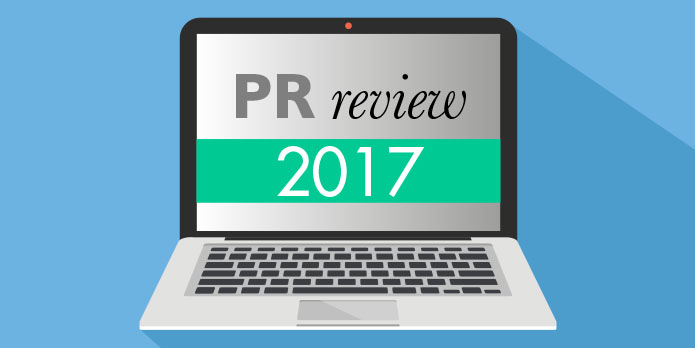
Campaign fails, social media movements and alternative facts: a review of PR in 2017
Hindsight is a wonderful thing, but there are probably several brands and organisations worldwide wondering what could have happened if they’d paid closer attention to their communications this year. There’s no question we’ve witnessed some valuable public relations lessons during the past 12 months – some stemming from positive situations, others from less so. As 2017 draws to a close, I thought it would be interesting to take a closer look at a few of them.
Lesson 1: When faced with a crisis, take responsibility.
In April 2017, United Airlines found itself at the centre of an image crisis when film footage emerged of a passenger being dragged off one of their flights, bloody and screaming, to make room for a crew member. The video went viral, prompting the airline’s CEO, Oscar Munoz, to apologise for having to “re-accommodate” passengers. Many felt his initial apology lacked sincerity, a situation not helped by an internal letter that quickly went public, in which he defended his staff and described the passenger, 69-year-old Dr David Dao, as “disruptive and belligerent”. The company’s market value dropped and Munoz went on to issue yet more apologies, pledging to review the incident and change the airline’s overbooking system. But the damage had been done. This PR disaster highlights the importance of saying sorry and meaning it. Say it once, say it well and say it sooner rather than later.
Lesson 2: Understand your audience.
Remember that ill-fated ad Pepsi released in April this year, featuring reality TV star and model, Kendall Jenner, at a protest? For those who need a recap, in the two-and-a-half minute film Jenner gives a white police officer attending a protest a can of Pepsi, which he accepts with a smile to cheers from the protestors. Many felt the ad was tone-deaf, trivialising the important messaging of recent protest movements, such as Black Lives Matter and the Women’s March. Within two days, Pepsi had pulled the ad and issued an apology, acknowledging it had “clearly missed the mark”. Ill-judged on several fronts, the ad is likely to be used for many years as an example of why you shouldn’t use celebrities to co-opt a political issue for your own profit. Faking a stand on issues rarely comes across as sincere, and using a celebrity – even one with such enormous social media influence – only reaps rewards when they’re the right fit for the right message.
Lesson 3: Trust is key.
Sean Spicer’s ill-fated role as White House Press Secretary this year serves as a reminder to all public relations professionals of the importance of maintaining trust and credibility. Spicer’s tenure didn’t get off to the best of starts, with an angry attack on journalists he claimed had deliberately minimised the turn-out for President Trump’s inauguration – despite photographic evidence supporting reporters’ claims. President Trump’s counselor, Kellyanne Conway, later defended Spicer’s comments, saying he had given “alternative facts” – a phrase that went on to launch a thousand memes. All public relations professionals know that if people don’t trust what you are saying, it undermines both you and your messaging. As Spicer was quick to discover, ignore this at your peril.
Lesson 4: Pictures are still worth a thousand words.
In April 2017, a photograph of Saffiyah Khan smiling in the face of an angry English Defence League (EDL) protestor in Birmingham city centre went viral. The image was taken by Joe Giddens, a Press Association photographer, during an EDL protest and was seen by many to represent resistance in the face of those promoting far-right views. Despite heavy police presence and widespread political condemnation of the protests, it was this image that seemed to dominate headlines. Saffiyah, then 20, said the photo was taken after she stepped in to defend Saira Zafar, who was dressed in a hijab and found herself surrounded by protestors, after she called them racists. The subsequent interest from media worldwide helped launch Saffiyah’s new career as a left-wing activist. Proof, if we needed it, that the power of the photo remains king.
Lesson 5: Social media remains a powerful platform for positive change.
In the wake of revelations this October about Hollywood mogul Harvey Weinstein’s conduct came #MeToo, a global social media movement started by women who had experienced sexual assault and harassment. First tweeted by actor Alyssa Milano, #MeToo quickly gathered pace, with countless men and women worldwide summoning the strength to use it (or a translated variation) to share their own experiences. Those who stepped forward, referred to as ‘the silence breakers’, have since been named “Person of the Year” by Time magazine. The magazine attributed the award not just to the women who sparked the movement but to the many women and men who have since broken their silence and, in doing so, given other survivors worldwide the courage to do likewise – uplifting evidence of social media’s continued capacity to empower and assert change.
There have been many interesting lessons over the past year but they all come back to one salient take-away – never underestimate the need for a strong communications and public relations strategy.
Angharad Neagle
This article appeared in the Western Mail newspaper on 18 December 2017.
Angharad Neagle is group managing director of Freshwater UK, the Cardiff-headquartered communications consultancy.
